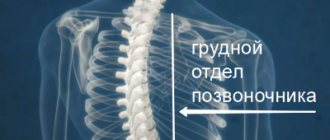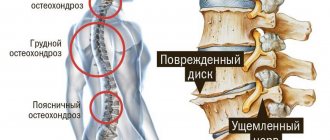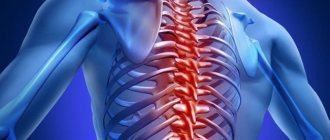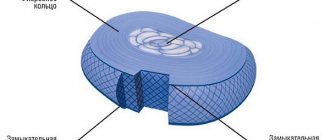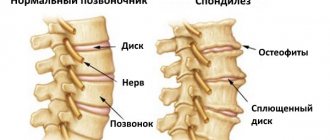Pain in thoracic osteochondrosis can be acute and chronic, dull and stabbing, cutting, tearing, shooting, etc. Pain syndrome is a sign of serious damage to the cartilage tissue of the fibrous ring of the intervertebral discs.
The thoracic spine has a specific structure. Here there is an attachment of twelve pairs of costal arches that form the chest. The vertebral bodies in this section have special notches that are a structural part of the costovertebral joints. Low mobility and high physical activity lead to rapid depletion of intervertebral discs.
Constantly present pain in osteochondrosis of the thoracic region can radiate (give) to the arm, abdomen, hypochondrium, sternum, shoulder, and areas of the heart. Quite often, patients confuse this symptom of dorsopathy with coronary heart disease, gastritis, pancreatitis, an attack of biliary colic, biliary dyskinesia, etc.
Only a thorough clinical diagnosis allows one to differentiate pain due to osteochondrosis of the thoracic spine from damage to internal organs. To carry out diagnostics, you need to see a vertebrologist (this doctor deals with problems of the spinal column). You can make an appointment for a free appointment with a vertebrologist in Moscow at our manual therapy clinic. Call the administrator and agree on a time convenient for your visit. During the appointment, the doctor will conduct an examination, make a preliminary diagnosis and prescribe appropriate treatment. Additional testing will be recommended as needed. Typically, a simple x-ray is sufficient to show degeneration and deformation of the intervertebral discs.
Where does the pain in thoracic osteochondrosis go?
In order to understand where the pain in thoracic osteochondrosis goes, you need to understand the anatomy of this part of the musculoskeletal system of the human body. So, the thoracic region is formed by 12 vertebrae of a certain shape, articulated with the costal arches. Between the bodies there are intervertebral dikes. They consist of a dense fibrous ring and a nucleus pulposus located inside it. This formation is designed to evenly distribute the shock-absorbing load and protect the radicular nerves extending through the foraminal openings in the vertebral bodies from the spinal cord.
Compression of the radicular nerves results in irradiation (spread) of pain along the areas for which they are responsible for innervation. Therefore, the answer to the question of where pain in thoracic osteochondrosis may refer depends on which disc is affected and which radicular nerves are pinched.
Look at which areas are innervated by certain radicular nerves that extend from the spinal cord in the thoracic spine:
- T1 innervates the upper extremities, upper respiratory tract; when they are compressed, discomfort in the hands, cough, sore throat, shortness of breath, hoarseness may occur;
- T2 innervates the myocardium and the coronary vascular system (with prolonged inflammation, coronary heart disease and damage to its membranes may occur);
- T3 is responsible for the chest, intercostal muscles, bronchi and lung tissue (severe pain in the intercostal spaces, intercostal neuralgia, difficulty breathing may appear);
- T4 innervates the liver and bile ducts (can provoke the development of dyskinesia or cholelithiasis, weakness of the walls of the gallbladder);
- T5 partially forms the solar plexus, so when this radicular nerve is pinched, the patient may notice pain in the area of the manubrium of the sternum and just below it;
- T6 and T7 are involved in ensuring the functioning of the pancreas, duodenum and muscle wall of the stomach;
- T8 innervates the diaphragm and can provoke attacks of hiccups;
- T9 is responsible for the innervation of the immune system and adrenal glands;
- T10 and T11 innervate the kidneys and ureters;
- T12 is responsible for the peristalsis of the small and large intestines, and can provoke pain in the abdominal area and prolonged constipation.
As you can see, with radicular syndrome, osteochondrosis of the thoracic spine can affect the most important organs and life support systems of the human body. Therefore, if its clinical symptoms appear, you should immediately seek medical help.
Pain in the lower abdomen in men
The causes of pain in the lower abdomen in the male population may be associated with pathological conditions of the reproductive and urinary systems. You can see them in the table below:
| Etiology | Character, what is accompanied by |
| Orchitis and epididymitis | Severe pain in the lower abdomen that extends to the groin and even the lower back. |
| Prostatitis | Vivid pain not only in the lower abdomen, but also in the lower back, scrotum, and lower back. |
| Neoplasms of the genitourinary system | Aching pain in the lower abdomen, which becomes more pronounced during sexual intercourse or with prolonged abstinence. |
| Stones in the ureter and lower third of the ureter | Painful symptoms of a spasmodic, girdling nature against the background of elevated body temperature. |
Can the chest hurt with osteochondrosis?
Chest pain with osteochondrosis can be caused by several factors. First of all, this symptom can occur when the T3 radicular nerve is damaged. It is responsible for the work of the intercostal muscles. They are unable to perform their functions, and the transmission of nerve impulses is disrupted. Myofascial pain syndrome occurs.
The second factor why the chest may hurt with osteochondrosis is that secondary spondyloarthrosis begins with degeneration and destruction of the intervertebral discs. The costovertebral joints are deformed. This causes severe pain in the chest area.
The third risk factor is the spread of the inflammatory process from the lesion of the fibrous ring. There is swelling of the soft tissues, increased capillary blood supply, and compression of small nerve endings. Palpation can reveal tension syndrome in the muscular frame of the back.
Other reasons
Not all pain in the lower abdomen is associated with the physiological characteristics of the male or female body. Their reasons are presented in our table:
| Etiology | Character, what is accompanied by |
| Inflammation of the appendix | Pain in the right iliac region upon palpation, a feeling of fullness, increased temperature in the right axilla, etc. |
| Dystrophic-inflammatory changes in the gastric mucosa - gastritis | Pain in the lower abdomen and chest, accompanied by dyspepsia: heaviness and a feeling of pressure in the epigastric region, unpleasant taste in the mouth, heartburn. |
| Infectious diseases of the pelvic organs: chlamydia, gonorrhea, mycoplasmosis, trichomoniasis | Transmission occurs through sexual contact. The pain is accompanied by burning and itching in the genitals, high fever, and inflammation of the skin. |
| Intestinal colic due to various reasons | Symptoms decrease with gentle pressure on the abdomen and are accompanied by constipation, vomiting, and false urge to defecate. |
| Pancreatitis | The pain spreads to the lower abdomen and chest and is accompanied by vomiting of bile, constipation, and bloating. |
| Peritonitis | Inflammatory processes of the peritoneum are characterized by intense pain, which can stop for 1-2 hours and occur again. Other signs: dry mouth, nausea, vomiting. |
| Urinary inflammation | Frequent urge to urinate (often every 5 minutes), increased cutting pain when urinating, increased body temperature, blood in the urine. |
The nature of pain in thoracic osteochondrosis
Many patients do not know what pain occurs with thoracic osteochondrosis and how they can be distinguished from symptoms of damage to internal organs. In order to understand what kind of pain is associated with osteochondrosis of the thoracic region, you need to know what causes them and the action of which pathogenic factors.
The nature of pain in thoracic osteochondrosis largely depends on the stage of the disease, the degree of damage to the fibrous ring of the intervertebral disc and a number of other factors:
- the primary attack is accompanied by acute pain, intensifying with any body movements;
- in the chronic course of osteochondrosis, the pain takes on a dull character with a constant presence;
- disc protrusion is accompanied by compression of the radicular nerve - pain begins to spread from the thoracic spine to the abdomen, shoulder, under the shoulder blade, and to the front of the chest;
- during the inflammatory process, the pain is pulsating and acute;
- When a disc herniation occurs, the pain does not allow any movement, and the back muscles become tense.
It is quite easy to distinguish this pain from manifestations of pathologies of internal organs. It is necessary to palpate the spinous processes of the spine. Does it hurt when you press? Do you feel tension in your back muscles? This is highly likely to be thoracic osteochondrosis. The diagnosis can be confirmed using an x-ray.
Pain and spasm of the abdominal muscles with osteochondrosis
Osteochondrosis has a direct effect on the abdominal muscles from the very beginning of the development of this disease. With primary degenerative lesions in the cartilaginous tissues of the intervertebral discs, a reflex overstrain of the entire muscle frame in the affected area occurs. Meanwhile, spasm of the abdominal muscles with osteochondrosis entails a number of negative consequences:
- the process of degenerative dystrophic changes in the fibrous ring of the intervertebral disc is accelerated;
- there is a gradual smoothing of the natural curve of the spinal column in the lumbar region;
- curvature of the spine may be observed in the lateral projection;
- the position of the internal organs of the abdominal cavity changes, due to which their dysfunction is observed;
- Stagnation of bile begins and stones form in the gall bladder.
Pain in the abdominal muscles with osteochondrosis can provoke their overstrain, which entails a change in intestinal motility. There may be disturbances in the functioning of the bladder.
Only an experienced doctor can make a correct diagnosis when abdominal pain occurs. You should not try to figure out on your own whether it is lumbar osteochondrosis that radiates to the stomach or whether a disease of the internal organs is developing. This may cause you to miss the time needed for emergency treatment. After all, incorrect treatment often serves as a reason for diseases to become chronic. Therefore, you should not sit at home and wonder: is it lumbar osteochondrosis that causes abdominal pain or serious problems with the visceral organs.
For example, with osteochondrosis, pain radiates to the abdomen in the area where the appendix is located. But this may also be inflammation of the appendix, which requires immediate surgical intervention. Otherwise, the appendix will rupture and purulent peritonitis will develop. And this condition is considered fatal. At home, it is impossible to independently distinguish an attack of appendicitis, pancreatitis, biliary or renal colic from manifestations of osteochondrosis. Therefore, do not risk your life and health. Seek medical attention.
The doctor will make an accurate diagnosis and prescribe effective treatment.
Pain in the heart with osteochondrosis of the thoracic region
Constantly present pain in the heart with thoracic osteochondrosis can be reflected or true. The T2 radicular nerves are responsible for the performance of the entire coronary circulatory system, the work of the pacemaker, and the regeneration of the myocardial membranes. Therefore, if a protrusion develops in the area of this disc, then there is a high probability that pain in the heart due to osteochondrosis of the thoracic region is true.
Currently, many doctors in city clinics strive to diagnose and treat one leading disease. In fact, multiple organ pathology cannot be excluded. Thus, when diagnosing thoracic osteochondrosis, it is possible that the patient also has diseases of the heart and coronary system. Therefore, when complaints of discomfort in the chest appear, it is necessary to carry out differential diagnosis in order to exclude coronary heart disease, arrhythmia, pericarditis, myocarditis, valve system insufficiency, etc.
Severe chest and back pain
Very severe pain in thoracic osteochondrosis can occur during exacerbations or prolapse of a disc herniation. These conditions require immediate medical attention. When some radicular nerves are damaged, a condition that threatens the patient's life may occur.
Acute chest pain due to thoracic osteochondrosis can be relieved with the help of traction traction of the spinal column. This procedure is performed in combination with massage and osteopathy. For severe back pain due to osteochondrosis of the thoracic region, pharmacopuncture is also used.
Depending on the nature of the pain syndrome and its duration, treatment is carried out using kinesiotherapy and therapeutic exercises.
Chest pain can be caused by excessive tension in the muscular frame of the back. This compensatory function of the muscular system is triggered when the intervertebral disc is seriously damaged. If it fails to cope with its shock-absorbing function, then the muscles responsible for maintaining a certain position of the vertebral bodies become tense. In this way, compensatory protection of the radicular nerves occurs from compression by the bodies of neighboring vertebrae.
Why does my stomach hurt from lumbar osteochondrosis?
Let's continue to understand the question of why the stomach hurts with osteochondrosis and what negative changes can be observed. So, above we have already figured out how osteochondrosis occurs - a degenerative dystrophic disease of the intervertebral discs. Now let's talk about the role and function of intervertebral discs.
The lumbar spine consists of five massive vertebral bodies, separated from each other by cartilaginous intervertebral discs. At the junction of the lumbar and sacral regions there is the conditional center of gravity of the human body,
On the sides of the sacrum are the iliosacral joints, with the help of which the lower limbs are attached to the spinal column. This is where the maximum shock-absorbing load that occurs when walking and running is transmitted.
Intervertebral discs are responsible for uniform load distribution. They also protect the radicular nerves from compression by changing the position of the vertebral bodies when bending, twisting and turning the human torso.
The stomach hurts from lumbar osteochondrosis in the following cases:
- the nerve plexuses (lumbosacral and cauda equina) are pinched, resulting in disruption of the innervation of the internal organs of the abdominal cavity and small pelvis;
- there is a decrease in intestinal motility due to impaired innervation, spastic colitis, volvulus, etc. may occur);
- a decrease in motility of the muscular lining of the stomach develops, food begins to linger in its cavity, provoking the destruction of the mucous membrane under the influence of hydrochloric acid;
- Biliary dyskinesia may occur, as a result of which constipation begins to alternate with profuse diarrhea;
- with a decrease in muscle tone, the position of the visceral organs is disrupted and their function suffers.
Also, the stomach with lumbar osteochondrosis can hurt as a result of excessive muscle tension, curvature of the spine, due to displacement of the internal organs of the pelvic cavity, etc.
This condition is extremely dangerous. As noted by researchers, more than 30% of colorectal cancer cases are associated with impaired innervation of areas of the colon. As a result of a long course of lumbar osteochondrosis, the patient begins to suffer from spastic constipation. Against their background, feces accumulate in the cavity of the colon, which provokes genetic changes in the mucous membranes. Their cells begin to mutate and actively degenerate into carcinoids. Therefore, in order to prevent the development of colon cancer, it is necessary to promptly treat the lumbar spine.
Also, patients suffering from degenerative dystrophic changes in the lumbosacral spine often experience the development of scar deformities in the abdominal cavity. They have an increased risk of developing gallstones and urolithiasis. In approximately half of patients, diffuse changes in the tissues of the pancreas are detected, which significantly increases the risk of developing diabetes mellitus.
With thoracic osteochondrosis, the stomach may hurt
Does the stomach hurt with thoracic osteochondrosis or is it a referred pain due to damage to the lower intervertebral discs? In different situations the answer can be positive or negative. In most cases, abdominal pain with thoracic osteochondrosis is a consequence of dysfunction of the abdominal organs. This is a consequence of a violation of innervation when the structure of the radicular nerves is damaged. The stomach consists of a muscle layer that contracts, mixing the food bolus with gastric juice, and relaxes. If the intervertebral discs T6 and T7 are damaged, then there is a high probability that the muscular wall of the stomach does not contract and atony of this organ appears. Next, undigested food enters the small and large intestines. A complex pathological process is launched, ultimately leading to complete dysfunction of the digestive system. Dysbiosis, colitis, pancreatitis and atonic gastritis are formed. This condition in the future is fraught with the development of ulcerative processes and the growth of oncological tumors.
Therefore, with thoracic osteochondrosis, the stomach may hurt, or referred pain may be felt. Only an experienced vertebrologist can tell you the exact cause of unpleasant symptoms.
Treatment: how to relieve pain from thoracic osteochondrosis?
Complete treatment of pain due to thoracic osteochondrosis is possible only with an integrated approach. First, the doctor determines the exact cause of degeneration of the cartilage tissue of the intervertebral disc. Then the patient is given recommendations on how to eliminate these negative influence factors.
Before relieving pain from thoracic osteochondrosis, a differential diagnosis is carried out. It includes x-ray, MRI, ultrasound, ECG. These examinations make it possible to make an accurate diagnosis and, taking into account all identified pathologies, to develop an effective individual course of therapy.
The easiest way to relieve pain in osteochondrosis of the thoracic region is through the traction procedure. It is carried out under the supervision of a doctor using special equipment. Beforehand, the patient receives a special relaxing massage session. Then, using traction, the spaces between adjacent vertebral bodies increase. This helps to quickly relieve pressure on the radicular nerves. The pain goes away almost immediately.
The treatment does not end there. To prevent the pain from recurring in the future, the patient will need to undergo a full course of intervertebral disc restoration. It includes:
- therapeutic exercises and kinesiotherapy to restore the functionality of the muscular frame of the back and improve the diffuse nutrition of the fibrous ring of the intervertebral disc;
- massage and osteopathy to improve microcirculation of blood and lymphatic fluid in the area of inflammation;
- reflexology to trigger the regeneration of damaged tissue by using the body’s hidden reserves;
- laser exposure for the purpose of vaporization of intervertebral discs;
- electromyostimulation and other types of physiotherapy.
The course of treatment for pain due to thoracic osteochondrosis is always developed individually. Make an appointment for a free appointment with a vertebrologist at our manual therapy clinic and receive comprehensive information on your case.
